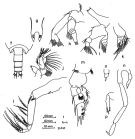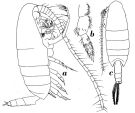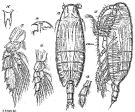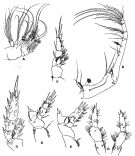|
|
 |
Fiche d'espèce de Copépode |
|
|
Calanoida ( Ordre ) |
|
|
|
Clausocalanoidea ( Superfamille ) |
|
|
|
Phaennidae ( Famille ) |
|
|
|
Onchocalanus ( Genre ) |
|
|
| |
Onchocalanus affinis With, 1915 (F,M) | |
| | | | | | | Syn.: | Onchocalanus hirtipes : A. Scott, 1909 (p.83, figs.F);
? O. affinis : Jespersen, 1940 (p.34); ? O. affinis : Tanaka & Omori, 1992 (p.263, Rem.M, figs.M) | | | | Ref.: | | | With, 1915 (p.233, figs.F,M); Sars, 1925 (p.150, figs.F); Rose, 1933 a (p.138, figs.F); Jespersen, 1940 (p.34, Rem.); Sewell, 1947 (p.135, figs.F, juv.); C.B. Wilson, 1950 (p.273, fig.F); Vervoort, 1950 a (p.26, figs.F,M, Rem.); Tanaka, 1960 a (p.119, figs.M); Vervoort, 1965 (p.32, Rem.); Owre & Foyo, 1967 (p.57, figs.F,M); Tanaka & Omori, 1992 (p.261, figs.F); Chihara & Murano, 1997 (p.853, Pl.140,141: F,M); Vives & Shmeleva, 2007 (p.692, figs.F,M, Rem.) |  issued from : O. Tanaka & M. Omori in Publs Seto Mar. Biol. Lab., 1992, 35 (4/5). [p.262, Fig.4, a-e]. Female (from Izu Region, Japan): a, forehead (lateral); b, last thoracic segment and urosome (lateral right side); c, Mx1; d, P5; e, distal segment of P5. Nota: The specimen agreed well with Sewell (1947), except for Mx1 of which 1st inner lobe bears 10 setae, 2nd and 3rd lobes with 2 and 4 setae, respectively. 1st exopodal segment of P1 armed with 3-4 spinules at base of outer marginal spine; 2nd segment with 11 spinules and 3rd segment with 3 groups of 3, 9 and 7 spinules, respectively. Distal segment of P5 armed with 2 apical spines and 1 outer marginal spine.
|
 issued from : O. Tanaka in Publ. Sero Mar. Biol. Lab., 1960, VIII (1). [p.120, Fig.97]. Male (from Suruga Bay, Japan): a, habitus (dorsal); b, forehead (lateral); c, last thoracic segment and urosome (lateral left side); d, rostrum (anterior aspect); e, Mx1; f, Mx2; g, Mxp; h, P5. Nota: Head and 1st thoracic segment separate, 4th and 5th separate. Rostrum with a strong base to which 2 short spines are attached. Abdomen contaibed 3.8 times in the length of the cephalothorax. Abdominal segments and furcal rami are in the proportional lengths 22 : 29 : 20 : 13 : 4 : 12 = 100; the 2nd to 4th segments are fringed with fine teeth on the distal border. Caudal rami about as long as wide. Left P5 5-jointed; the distal joint has 2 apical spines, the inner margin haired; the 3rd and 4th joints have each a distal spine. The right P5 4-jointed and short, the distal joint has an apical and small outeredge spine. A2 with exopodite 3/4 as long as the endopodite. Mx1 with very poor setae on the 1st inner lobe. Mx2 with a strong spine on the 5th lobe; the distal segments poorly developed. Mxp with the 2nd basal segment with a row of serrations at the anterior proximal margin; the spinulation of thje 1st basal segment much reduced; there is a minute sensory filament at the proximal margin.
|
 issued from : O. Tanaka & M. Omori in Publs Seto Mar. Biol. Lab., 1992, 35 (4/5). [p.263, Fig.4, f-p]. With doubt. Male: f, last thoracic segment and urosome (dorsal); g, rostrum (anterior view); h, A2; i, Md; j, Mx1; k, Mx2; l, Mxp; m, P1; n, P5; o, distal part of right P5; p, distal part of lzft P5. Nota: Rostrum bearing a pair of spines with small filaments at apex. Urosomal segments and caudal ramus have proportional lengths 24 : 26 : 22 : 16 : 1: 11 = 100. 1st and 2nd exopod of P1 without spinules on posterior surface. P5 5-segmented on right, 4-segmented on left; distal segment of right leg armed with 2 small spines at distal margin; left distal segment with apical spine and small subapical spine , but lacks 3 short hairs on 2nd segment. For the authors, male of O. affinis closely resembles O. hirtipes. Structure of P5 is not consistent between the two speciesthis specimen does not permit to reach a conclusion that it is definitively O. affinis.
|
 Issued from : W. Vervoort in Zool. Verh., Leiden, 1950, 10. [p.28, Fig.12]. Female (from Flores Sea): a, habitus (lateral right side); b, left P5 (posterior); c, habitus (dorsal). Nota: The abdominal segments and furca in the proportional lengths 42:26:16:4:12 = 100.
|
 Issued from : W. Vervoort in Zool. Verh., Leiden, 1950, 10. [p.29, Fig.13]. Female (from Flores Sea): a, posterior part of cephalothorax and urosome (dorsal); b, left P1 (posterior); c, right Mx2; d, forehead (lateral); e, posterior part of cephalothorax and urosome (lateral right side).
|
 Issued from : W. Vervoort in Zool. Verh., Leiden, 1950, 10. [p.30, Fig.14]. Male (from Ombai Strait: 163.8°S, 124°24'.5E): a, posterior part of cephalothorax and urosome (dorso-lateral left side); b, P5 (left leg figured on right side); c, cephalon (lateral). Nota: 2nd segment of left P5 with curved and stiff hairs at about half the length (not mentioned in With's description). A1 extend to the furca
|
 Issued from : G.O. Sars in Résult. Camp. Scient. Prince Albert I, 69, pls.1-127 (1924). [Pl.XLI, figs.12-18]. Female: 12, habitus (dorsal); 13, idem (lateral left side); 14, forehead (lateral); 15, rostrum (frontal view); 16, P1; 17, P3; 18, P5.
|
 issued from : R.B.S. Sewell in The John Murray Expedition, 1933-34, Scientific Reports, VIII (1), 1947. [p.136, Fig.32]. Female (from Arabian Sea): A, Mx2; B, Mxp; C, P1; D, P2; E, right P4; F, left P4; G, P5. Nota: The proportional lengths of the various segments of the body (cephalon to caudal rami) as 325:149:115:93:62:118:62:43:7:26 = 1000. Forehead without crest. The rostrum is a pair of strong spines. The line of demarcation between the head and the st pediger segment is clearly visible dorsally, incomplete laterally, 4th and 5th separate. There are some small short hairs aroud the genital orifice. Anal segment hairy ventrally, and there are some spinules on the dorsal aspect of the caudal rami. A124-segmented (segments 8-9 fused) reaches back to beyond the posterior margin of the genital segment. In Mx1 the various lobes bear the following spines and setae: inner lobe 1 with 9 ?, the spines are longer than the lobe itself; inner lobe 2 (?); inner lobe 3 (4 setae); basal segment 2 (5); endopod 1 (3); endopod 2 (3); endopod 3 (4); exopod (10); outer lobe (9 setae). In Mx2 two of the sensory appendages, arising from the terminal part of the appendage are markedly stouter than the others.
|
 issued from : A. Scott in Siboga-Expedition, 1909, XIX a. [Plate XXXIV, Figs.9-17]. As Onchocalanus hirtipes. Female (from Manipa Strait): 9, habitus (dorsal); 10, forehead (lateral); 11, last thoracic and genital segments (left side); 12, rostrum; 13, A1; 14, Mx2 (distal portion); 15, P2; 16, P4; 17, P5.
|
 issued from : H.B. Owre & M. Foyo in Fauna Caribaea, 1, Crustacea, 1: Copepoda. Copepods of the Florida Current. [p.58, Figs.357-360]. Female (from 15°00'N, 67°05'W): 357, habitus (lateral); 358, rostrum; 359, P5. Nota: Forehead without a crest. Male: 360, P5.
|
 issued from : O. Tanaka in Publ. Sero Mar. Biol. Lab., 1960, VIII (1). [p. 119]. Male: Proportional lengths of segments of A1. Nota: A1 24-segmented, extends to the distal end of the 4th abdominal segment. Segments 19 and 20 fused on the right side. The segments 20, 21 and 24 devoided of aesthetasc.
| | | | | Ref. compl.: | | | Sewell, 1948 (p.330, 501, 521, 526, 530, 546, 549); Minoda, 1958 (p.253, Table 2, abundance); Grice & Hulsemann, 1967 (p.16); Roe, 1972 (p.277, tabl.1, tabl.2); Kovalev & Shmeleva, 1982 (p.83); Vives, 1982 (p.291): Belmonte, 2018 (p.273, Table I: Italian zones) | | | | NZ: | 11 | | |
|
Carte de distribution de Onchocalanus affinis par zones géographiques
|
| | | | | | | | | | Loc: | | | G. of Guinea (off Ghana), off Mauritania, Canary Is., Azores, Caribbean, Sargasso Sea, S Iceland, W Medit. (Tyrrhenian Sea), G. of Oman, Arabian Sea, W Indian, Indonesia-Malaysia, Philippines, Japan (Izu region), Kamchatka, off Peru (in C.B. Wilson, 1950) | | | | N: | 18 | | | | Lg.: | | | (1) F: 5,5; (4) M: 5,86; (5) F: 5; (7) F: 6,3; M: 5,19; (11) F: 5,133; (16) F: 4,9-4,8; M: 4,4-4,35; (64) F: 4,85; M: 4,1; (199) F: 5,02-4,94; M: 4,33; (867) F: 5,7-6,5; {F: 4,80-6,50; M: 4,10-5,86} | | | | Rem.: | bathypélagique.
Signalisation originale en Méditerranée in Kovalev & Shmeleva (1982). | | | Dernière mise à jour : 06/02/2020 | |
|
|
 Toute utilisation de ce site pour une publication sera mentionnée avec la référence suivante : Toute utilisation de ce site pour une publication sera mentionnée avec la référence suivante :
Razouls C., Desreumaux N., Kouwenberg J. et de Bovée F., 2005-2025. - Biodiversité des Copépodes planctoniques marins (morphologie, répartition géographique et données biologiques). Sorbonne Université, CNRS. Disponible sur http://copepodes.obs-banyuls.fr [Accédé le 29 décembre 2025] © copyright 2005-2025 Sorbonne Université, CNRS
|
|
 |
 |













